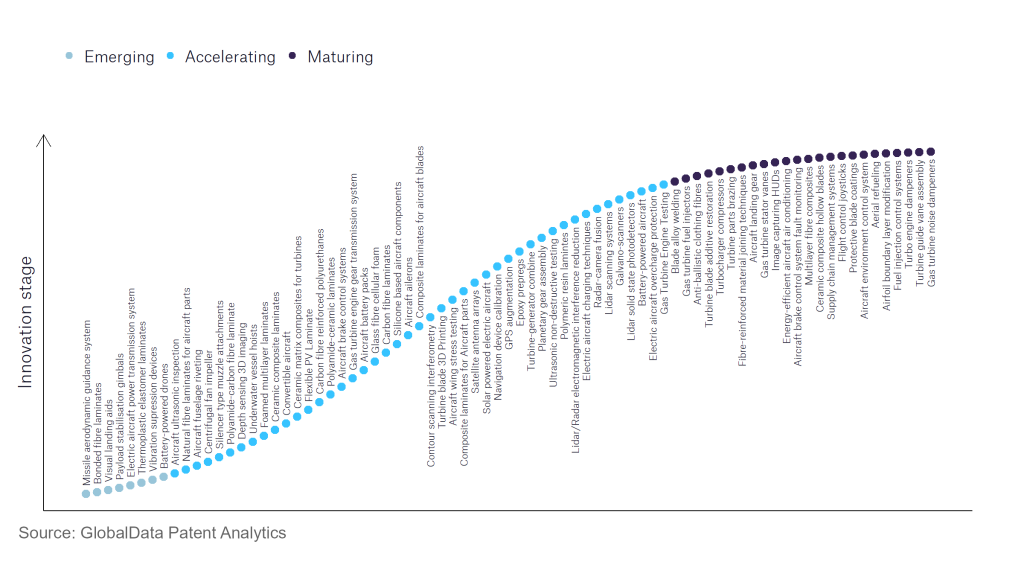The aerospace and defence industry continues to be a hotbed of innovation, with activity driven by the uptake of advanced technology, and growing importance of technologies such as hypersonics and advanced materials. In the last three years alone, there have been over 174,000 patents filed and granted in the aerospace and defence industry, according to GlobalData’s report on Innovation in Aerospace, Defence & Security: Polyamide-ceramic laminates. Buy the report here.
However, not all innovations are equal and nor do they follow a constant upward trend. Instead, their evolution takes the form of an S-shaped curve that reflects their typical lifecycle from early emergence to accelerating adoption, before finally stabilising and reaching maturity.
Identifying where a particular innovation is on this journey, especially those that are in the emerging and accelerating stages, is essential for understanding their current level of adoption and the likely future trajectory and impact they will have.
180+ innovations will shape the aerospace and defence industry
According to GlobalData’s Technology Foresights, which plots the S-curve for the aerospace and defence industry using innovation intensity models built on over 262,000 patents, there are 180+ innovation areas that will shape the future of the industry.
Within the emerging innovation stage, bonded fibre laminates, thermoplastic elastomer laminates, and vibration supression devices are disruptive technologies that are in the early stages of application and should be tracked closely. Centrifugal fan impellers, ceramic composite laminates, and gas turbine engine testing are some of the accelerating innovation areas, where adoption has been steadily increasing. Among maturing innovation areas are protective blade coatings and blade alloy welding, which are now well established in the industry.
Innovation S-curve for the aerospace and defence industry

Polyamide-ceramic laminates is a key innovation area in aerospace and defence
The composite material with ceramic and polymer laminated together is known to be highly resistant to penetration by other objects. Moreover, they are used in semiconductors and microelectronics which are both rapidly expanding areas in terms of both reach and demand. These properties make polyamide-ceramic laminates valuable for use in the aerospace and defence industries.
GlobalData’s analysis also uncovers the companies at the forefront of each innovation area and assesses the potential reach and impact of their patenting activity across different applications and geographies. According to GlobalData, there are 10+ companies, spanning technology vendors, established aerospace and defence companies, and up-and-coming start-ups engaged in the development and application of polyamide-ceramic laminates.
Key players in polyamide-ceramic laminates – a disruptive innovation in the aerospace and defence industry
‘Application diversity’ measures the number of different applications identified for each relevant patent and broadly splits companies into either ‘niche’ or ‘diversified’ innovators.
‘Geographic reach’ refers to the number of different countries each relevant patent is registered in and reflects the breadth of geographic application intended, ranging from ‘global’ to ‘local’.
Patent volumes related to polyamide-ceramic laminates
| Company | Total patents (2021 - 2023) | Premium intelligence on the world's largest companies |
| Toray Industries | 59 | Unlock Company Profile |
| Hexcel | 34 | Unlock Company Profile |
| Solvay | 19 | Unlock Company Profile |
| 3M | 14 | Unlock Company Profile |
| Hardwire | 13 | Unlock Company Profile |
| Boeing | 11 | Unlock Company Profile |
| Showa Denko | 10 | Unlock Company Profile |
| BAE Systems | 10 | Unlock Company Profile |
| Fujifilm Holdings | 9 | Unlock Company Profile |
| Honeywell International | 9 | Unlock Company Profile |
| Gurit Holding | 7 | Unlock Company Profile |
| Rolls-Royce Holdings | 6 | Unlock Company Profile |
| General Motors | 6 | Unlock Company Profile |
| National Aeronautics and Space Administration | 6 | Unlock Company Profile |
| DuPont de Nemours | 6 | Unlock Company Profile |
Source: GlobalData Patent Analytics
Polyamide-ceramic laminates have both commercial and military applications. Amongst aerospace and defence companies, Boeing is the leading patent filer in the technology in polyamide-ceramic laminates, followed by BAE Systems, National Aeronautics and Space Administration (NASA), and Rolls-Royce. Boeing is heavily involved in the development of highspeed aircraft, both through its defence and commercial businesses. Polyamide-ceramic laminates have applications in the construction of airframes, allowing manufacturers to strengthen aircraft bodies, whilst limiting the overall weight.
In terms of application diversity, National Aeronautics and Space Administration (NASA) leads the pack, followed by BAE Systems and Rolls-Royce in the second and third positions, respectively. By means of geographic reach, Boeing holds the top position, followed by BAE Systems, National Aeronautics and Space Administration (NASA), and Rolls-Royce. Polyamide-ceramic laminates are high-strength, lightweight materials, with significant applications in the aerospace and defense industry, from aircraft airframes to semiconductors and microelectronics.
To further understand the key themes and technologies disrupting the aerospace and defence industry, access GlobalData’s latest thematic research report on Defence.
Data Insights
From

The gold standard of business intelligence.
Blending expert knowledge with cutting-edge technology, GlobalData’s unrivalled proprietary data will enable you to decode what’s happening in your market. You can make better informed decisions and gain a future-proof advantage over your competitors.



